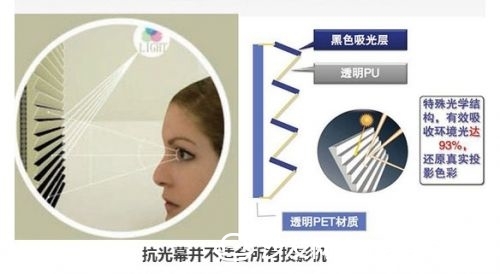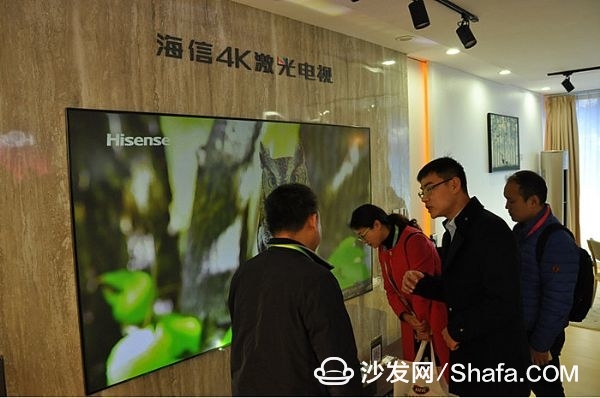Why do we need anti-light curtains? The light curtain is really important! The reason is very simple, that is, our laser television needs to be used under the light conditions. The lighting environment significantly affects the “generation†of the screen contrast. First of all, the first focus of many consumers on the projector display system is brightness. The author does not think there is any problem with this understanding. Because the brightness of the projector is not only related to the application effect of the product, but also directly proportional to the price. However, for most home projectors and laser televisions in the 3000-4000 lumens, the brightness is actually "invariant." More importantly, what is the key element of a good picture? It is color and contrast - not brightness. That is, the projector is not a lamp. His core is not lighting. The reason why the projector cares about the brightness is mainly because "the brightness packs the most core energy required for contrast." However, the contrast does not depend entirely on brightness. Because the contrast is "bright and not bright" than it. In a dark environment, this "unlit" level is determined by the projector. In an illuminated environment, this "unlit" level is mainly affected by the brightness of the ambient light. Under normal circumstances, indoor brightness, including natural lighting and artificial lighting, will not be less than 100 lumens. More can reach 200 lumens, or even higher. This is equivalent to having a brightness of at least 100 lumens on the projection screen (whether it is a large screen projection or a small screen projection, the brightness value does not change). For a projector with only 3,000 lumens of brightness, even if a 60-inch “small screen†is projected, this means that the final contrast ratio is difficult to reach 30:1. The above cases are a lot of projection applications. In the light environment, the screen presents the overall "grey" effect, there is no sense of hierarchy, and there is no reason for the colorful sense. However, if the projection screen used is a "light-resistant screen," most of the ambient light will be absorbed - 100 lumens, and only 30 lumens or 5 lumens may be reflected. Coupled with the human eye's own pupil regulation and changes in light sensitivity, the projection screen can display "pure" black. Therefore, the reason for choosing the light curtain in the simplest language is that a good projection system sees that the contrast and good contrast are determined by the ambient light and the treatment of the ambient light. The work of the light curtain is "handling ambient light." High-tech light curtain, only two doorways Anti-light curtain is almost the "key" of laser projector to achieve television display effect. How does the light curtain work? First, "absorption" is the most basic anti-light measure. All the light curtains on the market are now "dark colors." Deeper colors mean more absorption of light. The more powerful absorption also means less reflection, which results in a sharper contrast effect. From this perspective, all dark curtains can become light curtains. However, absorption technology has a flaw: that is, 100% absorption technology, at the same time lead to zero screen brightness. The projection screen is based on reflected light imaging. This determines that it is not that there is no better absorption of materials and technologies, but that absorption in light-resistant designs cannot be “too highâ€. - The white beauty cannot be completely sacrificed for the beauty of blackness. Give the screen enough brightness. This decision also determines the screen that simply absorbs the light, and the light-resistance effect must be greatly reduced. Second, optical reflection is an important anti-light measure. In laser television, the projector uses a reflective short-focus lens. The angle between the projection light of the projector and the screen is small. Ambient light, on the other hand, comes from the lighting of the roof, the sunlight of the windows, and the diffuse reflection in the house. Most of these rays have a large angle with the projection screen, and even a third of the energy is almost perpendicular to the screen. Using projection light and ambient light for different angles of the projection screen, the projection screen can be designed with a unique optical structure - this structure is mainly to completely reflect the ambient light in the opposite direction of the projection light to the imaging angle of view, while taking the screen angle Most of the ambient light that is near vertical is also reflected outside the imaging perspective. In turn, high-contrast clear images are left for imaging perspective. There are several prerequisites for using reflective technology to counteract ambient light: First, the projection light must have a large gap with the direction and angle of the ambient light so that an efficient mirror can be designed. This point determines that reflective anti-ambient light is of little use in telephoto projection engineering. Second, the structure of the screen mirror and the projection angle of the projector have a match, that is, the relative positions of the screen and the projector need to be placed strictly in accordance with design specifications during the installation process. Third, for larger projection screens, it is difficult for short-focus lenses to maintain "small enough projection rays and screen angle." That is, this kind of optical anti-light curtain based on reflection technology has obstacles in the application of large-scale projection - although this obstacle is not caused by the projection screen, but is caused by the design of the projection lens. Third, the light curtain of Fresnel's bionic structure. After an anti-light curtain applied both absorption and optical reflection, its effect against ambient light was already good. However, this does not mean that the anti-light curtain cannot be made more elaborate. General reflective light-resistant technology, the entire screen using a single-shaped reflective structure. The high-end Fresnel bionic structure adopts more anti-light structures that are redesigned according to the different angle positions of the screen and the projector. This design of the screen, the picture will be better. However, it also has its disadvantages: On the one hand, the production cost of such curtains is higher; on the other hand, once the projector position or screen size changes, it means that the anti-light curtain may have to redesign the optical structure. Fourth, if the anti-light curtain uses optical reflection technology, then he will have a more clear concept of "resolution." Especially for the display of the 4K screen, each reflection structure of the anti-light curtain is required to be more compact and refined so as to ensure the display effect of each pixel. Fifth, if the anti-light curtain uses optical reflection technology, such curtains are generally hard curtains, not soft curtains. The hard screen also has better features of “flatness†on the display. However, the ease of moving and handling hard screens must also be discounted. In summary, the core anti-light technology of the light curtain is nothing more than absorbing coating and optical reflective structure. The general anti-light curtain for laser televisions requires the simultaneous use of these two technologies. And it is preferable that the design of the optical structure has a plurality of independent designs depending on the angle of light of the incident screen. Anti-light curtains are so important that chaos in the market is inevitable For a laser television system, the light curtain is an important component. Only from the cost point of view, a good 100-inch light curtain also needs 5000-7000 yuan. And with the increase in size, the product prices rose significantly. Because of the high price of anti-light curtains, some businessmen have also played a bad idea. The common light curtain resistance problems in the market are: simply covering the light curtain with a dark curtain; or simply filling the high-quality light curtain with an absorbing coating. In this regard, consumers need to look for the concept of “optical anti-light curtainsâ€. And to buy laser TVs, it is best to choose those brand products that are equipped with a light curtain. The latter helps consumers get a better service from the seller: At the time of installation, the screen and the projector's position and picture are carefully adjusted. In short, one of the key differences between laser television applications and traditional projection displays is the "standard" of light-resistant screens. From this point of view, laser television is by no means a simple "no screen" concept - it really needs a high-level screen to be able to deserve the word TV, so that in the light conditions, the screen is still clear and beautiful. High Speed Bag Making Machine,High-Speed Continuous Roll Bag Making Machine,Automatic Roll Bag Making Machine,Compound One System Bag Machine Dongguan Yuantong Technology Co., Ltd. , https://www.ytbagmachine.com

Smart TV/box information can focus on smart TV information network sofa butler (http://), China's influential TV box and smart TV website, providing information, communication, TV boxes, smart TVs, smart TV software, etc. Answering questions.
What are the hidden secrets behind the light curtain?
A good laser television system is inseparable from a good anti-light curtain - those so-called "no screen" concept, the so-called "300-inch giant screen on the wall", in the eyes of professional players are "rogue" . So what is the magic of the light curtain?